When Airbus conceived the all-new A350 XWB almost a decade ago, it did so after first attempting to create a challenger to the Boeing 787 based on its existing “big-twin”, the A330. As that aircraft’s conception saw it evolving away significantly from the type upon which it was based, and still not satisfying the needs of many customers, Airbus took the brave decision to abandon the original plan and adopt an all-new approach with A350 XWB, powered by advanced generation Rolls-Royce Trent XWB engines.
The challenge facing Airbus as it made its back-to-basics rethink was to create all-new airliner offering technology to match or better the all-new Dreamliner but retaining significant flightcrew commonality with the aircraft it was expected to replace – the A330. And while at first glance the two cockpits appear a world apart, the fundamental Airbus philosophy is unchanged and Airbus reports that A330 crews quickly feel fully at home in their new surroundings.
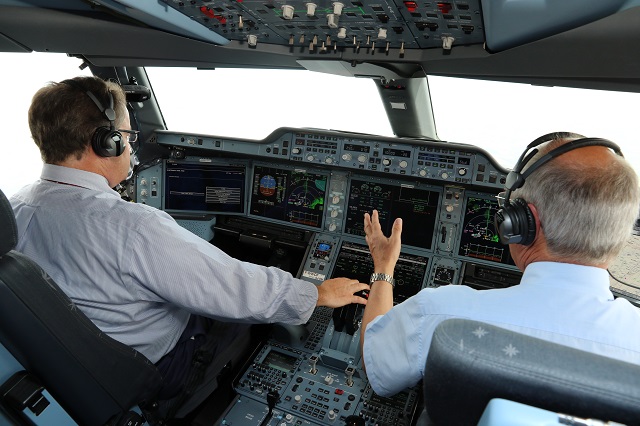
Author Michael Gerzanics (left) at the controls alongside Airbus chief test pilot Peter Chandler
Max Kingsley-Jones/Flightglobal
The all-new A350’s “Xtra Wide Body” moniker points to its hoped-for marketing advantage, a wider fuselage than the 787 (which itself had greater girth than the A330, whose cross-section was directly derived from the original Airbus, the A300B). According to Airbus, the XWB’s passenger cabin is 12.7cm (5in) wider than the Dreamliner’s, allowing nine-abreast economy layouts with seats, Airbus is proud to point out, that are 45.7cm wide at the armrests – 1.3cm more than 787.

Flightglobal took the controls of A350-900 MSN002 (above), which wears a distinctive "carbonfibre" scheme
Airbus
Some 15 months after its first flight on 14 June 2013, the baseline A350-900 received EASA certification on 30 September 2014, with US Federal Aviation Administration approval following on 12 November.
Launch customer Qatar Airways put the new big twin into revenue service on 15 January 2015, between Doha and Frankfurt. The Qatari carrier is due to debut the A350-900’s big brother, the -1000 stretch in mid-2017. However a third A350 derivative, the A350-800 “shrink”, is in limbo, having effectively been replaced in the Airbus line-up by the re-engined A330neo.
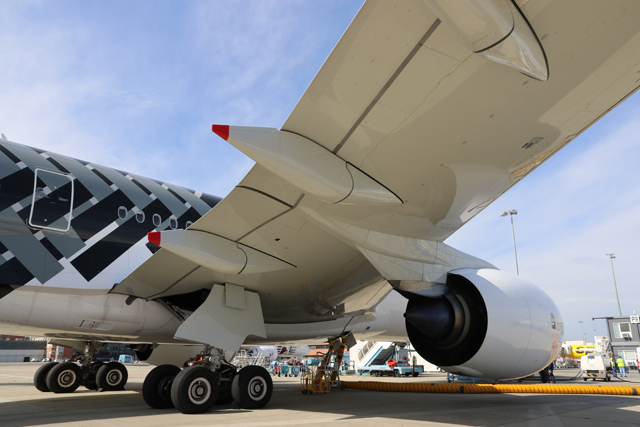
Trailing-edge flaps provide variable camber function in cruise
Max Kingsley-Jones/Flightglobal
Familiar feelings
Not long after the A350’s service debut, Flightglobal was invited to Toulouse to sample firsthand how Airbus’s biggest twin would fly.
Throughout my civil aviation career I have primarily flown Boeing products; ranging from the 737 to the 747 Classic. The newest Seattle product I was qualified to command was Boeing’s big twin, the 777. As a reporter for Flightglobal I was able to “fly” a 787-8 simulator prior to its delivery to Continental Airlines (now United Airlines), in 2010. While sidelined with an injury in 2012, I rode with Paul Smith during his evaluation flight of the 787 for Flightglobal.
Boeing had sought and obtained a common type rating for the 777 and 787, and in both the 787 simulator cab and cockpit I felt completely at home. Smith, who flies the 757/767 for a US freight carrier, remarked how the flows and overall feel of the 787 reminded him of his regular Boeing ride.
From a training and qualification standpoint, Boeing was leading the industry when it earned a common type rating for the 757 and 767. Having qualified on both the 757/767 and 777, I can attest that while they have different underlying architectures, they are remarkably similar from the pilot’s perspective. I think one can comfortably say that a pilot qualified in the 757/767 or 777/787 series would experience little challenge in transitioning to the other.
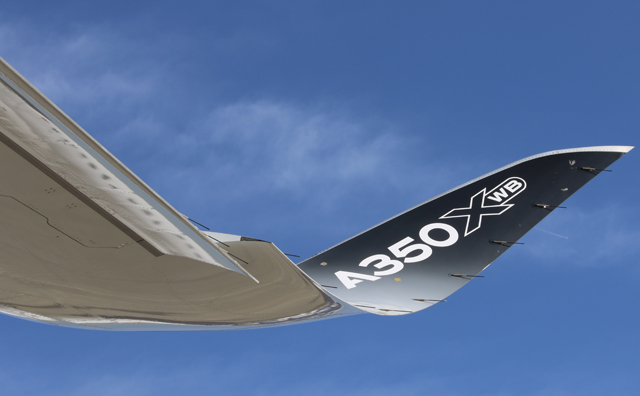
An all-new wing incorporates a 2.4m winglet
Max Kingsley-Jones/Flightglobal
Boeing’s efforts at fashioning a common cockpit environment are notable, but they are well eclipsed by Airbus’s efforts. While I have never been qualified to command an Airbus, as a reporter for Flightglobal I have been fortunate to have flown the A318, A340-600, A380 and several A330 simulators. With the A320, Airbus laid the foundation for a common flightdeck and flight control philosophy for its fly-by-wire (FBW) aircraft. Over the years I have observed and appreciated the commonality inherent in Airbus designs.
The most notable enhancement I had observed was when I flew the A380. While the A340-600 (and A330) has six square displays and virtually identical to the A320 family cockpit, Airbus took the opportunity with the A380 to refresh the arrangement. It has a total of eight much larger and rectangular (upright) displays. Additionally, the A380 cockpit incorporates an integrated electronic flight bag as part of the onboard information system (OIS) which is displayed on screens mounted on the left and right sidewall.
To interface with the A380’s OIS, full-size QWERTY keyboards are incorporated into each pilot’s fold-out table. Finally, two pedestal mounted keyboard and cursor control units (KCCUs) were installed. Each KCCU features a QWERTY keyboard as well as a track ball and scroll wheel. My view of the A380’s cockpit was that while I appreciated the large amount of real estate available to display information, in retrospect it lacked a clean, cohesive feel.
Flightdeck familiarisation
With Airbus chief test pilot Peter Chandler, I was able to re-acquaint myself with an Airbus flightdeck as we went over the highlights of the A350-900 in a full-motion simulator. Later that day Chandler hosted me and several other journalists on our preview flight onboard the real aircraft.
Like other Airbus flightdecks, the A350 employs a dark-cockpit philosophy. For the A350, Airbus took the A380 as a baseline and improved upon it. Six large 39cm-wide displays replace the A380’s eight smaller (15cm x 20cm) displays. Five displays are placed side by side from side wall to side wall on the forward instrument panel, the sixth below the middle display above the centre pedestal. Each display can be divided in half, yielding two 15cm x 20cm windows. Overall the instrument panel presented a clean appearance.
The simulator had optional Thales head-up displays installed. In addition to helping the pilots keep their eyes out of the cockpit, the HUD may be used in the future for Enhanced Vision System (EVS), Surface Guidance System (SGS) and Synthetic Vision System (SVS) displays. Like the A380, the A350 has tray table-mounted keyboards as well as two pedestal-mounted KCCUs. Unlike the A380, the A350’s KCCUs can interface with the OIS.
Chandler guided me through the flight management system initialisation procedures, which were easy to accomplish as the FMS automatically sequenced to the appropriate page. Like the A380, the A350 has a smart electronic checklist, one that will automatically “tick” accomplished items. In the event of an electronic centralised aircraft monitor (ECAM) announced abnormal/emergency procedure, the appropriate checklist and relevant system display are automatically presented. If a “non-sensed” abnormal/emergency condition is encountered, the appropriate checklist and system display can be selected from a menu presented when the ECAM control panel’s “ABN” button is pressed.
During our simulator brief, Chandler also highlighted several other features on the A350 that differed from the A330. One is the surveillance (SURV) system, which debuted on the A380 and integrates weather radar, traffic collision avoidance system (TCAS), terrain awareness warning system (TAWS) and air traffic control (ATC) mode S transponder components. These subsystems are controlled by a single pedestal-mounted panel.
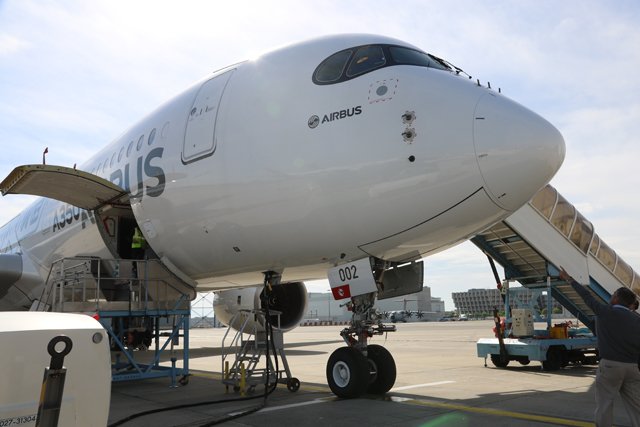
The nose is the most visually striking feature of the A350
Max Kingsley-Jones
Another is the “Brake” panel above the landing-gear lever, which has a single push button for the arming of three automatic braking modes, and a rotary switch to select runway condition. The first is auto-brake which, based on system logic, applies braking for a rejected take-off event or normal landing roll-out. The second, Brake to Vacate (BTV), was discussed in detail by Chandler while in the simulator.
BTV automatically brakes the aircraft for runway turn off at a pilot selected exit point. Airbus feels that BTV is a major evolution in braking control as it can optimise brake application and reduce runway occupancy time, all while enhancing passenger comfort.
Airbus originally developed BTV for the A380 and believes it is a major evolution in braking control as it optimises brake application and reduces runway occupancy time, all while enhancing passenger comfort.
The third is the Runway Overrun Protection (ROP) mode. With runway excursions on landing an ever-present threat, in the A350 Airbus has incorporated two features to reduce their likelihood. The Runway Overrun Warning (ROW) system is active at 500ft above ground level on approach, and computes real time stopping distance required. Should it determine there is insufficient runway available it triggers a visual and aural alert, designed to encourage the pilots to either go-around or correct approach parameters. The other is ROP which activates when the autobrake is active on roll-out. If an overrun is sensed, it commands maximum braking and issues visual and aural alerts for the pilots to use maximum reverse thrust.
Simulated circuit
Since the actual flight in the A350-900 was to be shared with several journalist pilots, I was determined to glean as much as I could from my time in the simulator. For the simulator exercise I occupied the left seat and fellow journalist pilot Greg Cellier in the right seat. Cellier was current and qualified on the A320 as a first officer for a European airline.
With familiarisation complete, Chandler guided us through the engine start process. Once both Trent XWB engines were stabilised at idle, post start flows were completed and set flaps 2. I released the parking brake and taxiied towards runway 14R at Airbus’s home port of Toulouse Blagnac.
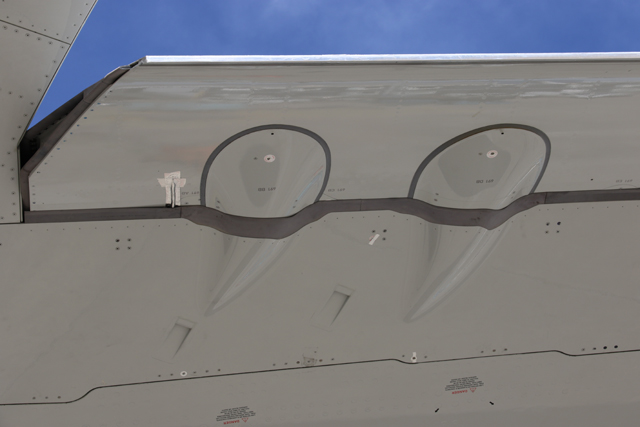
Vents for the aileron's EHA and EBHA on underside of surface
Max Kingsley-Jones/Flightglobal
Our simulator had the optional external and taxi aid camera system (ETACS) installed. Two cameras provide views from just behind the nose wheel and from the top of the vertical tail. I found the video feeds aided my taxiing on centerlines during my navigation around the digital rendition of Blagnac airport. During the taxi I was also able to see the A350’s airport navigation function operate. With navigation display (ND) ranges of 5nm (9.3km) and below, an airport diagram is presented.
Our own aircraft’s position was shown in magenta on the moving map. Runway intrusions are a constant threat, and Airbus has equipped the A350 with a runway proximity advisory (RPA) feature. Approaching a runway, the runway’s name and runway depiction itself will flash in yellow on the ND. An RPA message is also presented on the primary flight display and ETACS display. As I have noted on numerous other preview flights, having one’s position depicted on an airfield diagram greatly enhances situational awareness.
Once aligned on 14R, I advanced the thrust levers to the FLX/MCT (flexible/maximum continuous thrust) detent. The autothrust set a “FLX TO” take-off thrust setting. Power is displayed on the engine display in percentage, as determined by the Airbus Cockpit Universal Thrust Emulator (ACUTE).
ACUTE takes the engine control parameter and converts it into a common thrust parameter. This set-up is particularly useful for aircraft with several engine types as percentage thrust replaces the underlying controlling N1 fan speed or engine pressure ratio setting. Currently the Trent XWB is the only engine planned to be offered on the A350 series; but should a second engine type be certificated, the ACUTE system will minimise any required differences training.
When Cellier called “Rotate”, I pulled aft on the sidestick and followed the Flight Director’s guidance. Once airborne, gear and flap retraction caused no pitch changes as we accelerated and climbed to pattern altitude. I used the HUD to hand fly the aircraft around the visual circuit, its symbology reflective of that displayed on the PFD.
After Cellier installed and activated the 14R ILS approach in the FMS, I used the Flight Director cues in the HUD to hand fly the approach. I left the autothrust engaged, its accurate tracking of speeds on the approach simplifying my task loading while handling this big twin. At about 40ft radio altitude (RA) I began the round-out for the flare manoeuvre.
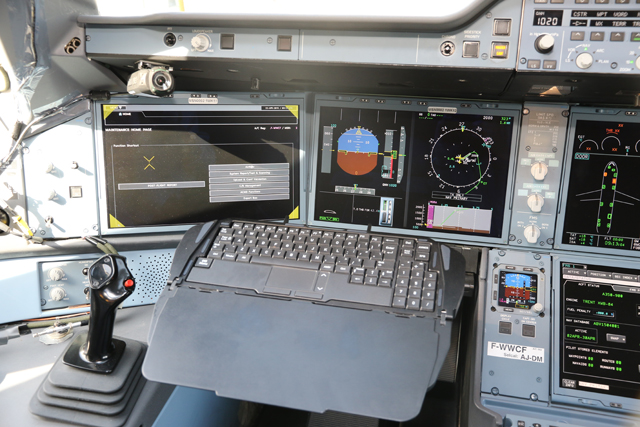
Each pilot has a table-mounted keyboard
Max Kingsley-Jones/Flightglobal
When “Retard” was annunciated at 20ft RA, I retarded the levers to idle. Nearing the idle stop, I clicked off the autothrust for the full-stop landing and manually braked to a halt.
Organic shape
Prior to our sortie, Airbus flight test engineer Bruno Bigand led us on a pre-flight inspection of our A350-900 preview aircraft, MSN002 (F-WWCF). This is the second A350-900 built but the third to fly as it was the first test aircraft to be completed with a furnished cabin. This aircraft, which was used primarily in the flight-test campaign for development and certification of the passenger cabin, is painted in a white and carbonfibre-look colour scheme to emphasise the advanced materials used in the A350’s construction. Composites alone make up 53% of the structure.
Visually I found the most striking feature of the A350 was its nose section. To my mind, the noses of large commercial aircraft have never been particularly appealing or sleek – apart from the Concorde. Airbus and Boeing with its 787 have gone to great lengths to reduce drag wherever they can. These new designs have an almost constant rake from the tip of the radome to the top of the fuselage, giving a look that is somewhat evocative of a Parrot’s beak.
In a nod to drag reduction, and perhaps simplicity, the A350 is the first Airbus to incorporate fixed cockpit windows. This change saves weight and complexity and allows a more aerodynamic glazing, and necessitated an overhead escape hatch for cockpit crew which is located above and behind the first officer’s seat (the 787 is similar in this respect). Long ropes are supplied for the up to 7.6m (25ft) drop to the ground.
The A350’s all-new wing spans 64.75m, including its signature 2.4m high winglet, and is primarily constructed of carbon composite materials. As with the A380, Airbus made extensive use of computational fluid dynamics and windtunnel testing to deliver an efficient wing optimized for a Mach 0.85 cruise speed. While not evident during the walk-around, the A350’s flight computers tweak the position (+/-4º) of the inboard and outboard flaps during the cruise. This capability gives the A350 a variable camber wing that can be optimised for real time flight conditions.
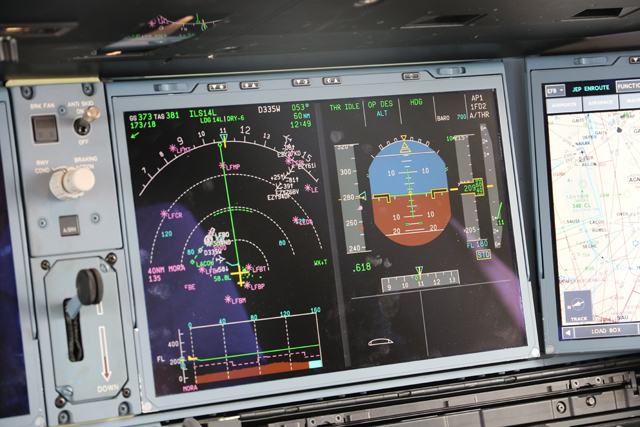
ND and PFD are integrated into a single screen
Max Kingsley-Jones/Flightglobal
The A350 only has two 345bar (5,000lb/in2) hydraulic circuits, just like the A380. To gain the required level of flight control redundancy, Airbus uses three types of control actuators: conventional, electro-hydrostatic actuator (EHA), and electrical back-up hydraulic actuator (EBHA). Conventional actuators use the ship’s green or yellow hydraulic systems, while EHAs have a self contained electro-hydraulic generation system. The EBHAs operate as conventional actuators until there is loss of hydraulic power, when they operate as EHAs. As we inspected the outboard trailing edge section of the wing, Bigand pointed out the vents for the aileron’s EHA and EBHA. Approaching the wing/body join, Bigand pointed out a unique feature of the A350’s main landing gear, which differs from previous Airbus designs. Each main strut is supported by two drag links, a more intricate configuration than usual designed to reduce loading on the wing.
After completing the walk around inspection we boarded the A350-900 and I went aft through the cabin. MSN002’s cabin is configured with a 252-seat layout comprising 42 business-class and 210 economy-class seats. As I walked aft I noted that the A350’s cabin was noticeably more open and airy than that of the A340-600 that I had ridden over to Europe on from San Francisco. I took a seat at the flight-test station installed half way down the cabin. The station had several monitors that allowed me to view flightdeck activities through several cameras, as well as repeat actual flightdeck displays. While designed for the flight test effort, the station allowed me to closely watch the cockpit and gain a better understanding of the A350 and its systems.
Envelope protections
From the flight test station I observed the normal start, taxi and take-off performed by another journalist pilot. An autopilot climb was established as we flew to the working area approximately 120km west of Toulouse.
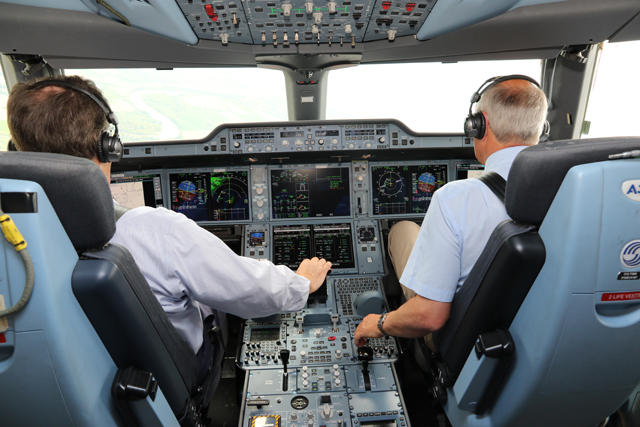
With Direct Law engaged, Gerzanics slows to 180kt to fly a series of 30' turns
Max Kingsley-Jones
At FL220 with the autopilot still engaged, the pilot disengaged the autothrust and advanced the thrust levers to the “CLB” detent. At 340kt (630km/h; all speed values are indicated air speed (IAS)) the PFD’s airspeed tape was red, indicating an overspeed. At 343kt the autothrust woke up and retarded the thrust level to slow the aircraft below VMO (maximum operating speed). Slowing through 340kt the autothrust disengaged itself, returning thrust control to the pilot.
Throughout this exercise, the autopilot stayed engaged. This overspeed protection feature is in addition to the flight control laws’ high speed protection scheme. That scheme limits the effect of pilot forward stick input, stabilising the aircraft at VMO+25kt/MMO (maximum operating Mach +0.06M).
Next the pilot explored the protections resident in the roll axis of the flight control laws. As with other Airbus civil fly-by-wire aircraft, up to 33º angle of bank can held with neutral lateral stick. Additionally, automatic pitch trim relieves the need for aft stick pressure to maintain level flight. Angles of bank up to 67º (clean configuration) can be obtained if a lateral stick input is held. Automatic pitch trim, however, is disabled and aft stick pressure is needed to maintain level flight.
In addition to its three full air data reference systems, the A350, as would be expected, has a third standby pitot static system. Even this level of redundancy however, has been known to fail. While there is no doubt a quick reaction handbook procedure to deal with this rare occurrence, Airbus has developed a backup system to further enhance safety. At high and medium altitudes, the A350’s backup air data system uses information from the engines nacelle mounted air data probes to compute aircraft speed and altitude.
At FL220 and about 250kt, Chandler switched the PFD’s air data to the tertiary backup source. Dashed lines were drawn through the PFD’s airspeed and altitude tapes to indicate degraded accuracy, but when it all settled out, indicated altitude and airspeed were within 20ft and 2kts of the primary system’s. While not demonstrated on our preview flight, Chandler said that at low altitudes the system uses inertial inputs to determine airspeed and global positioning system data to determine altitude.
Chandler next directed a descent to an altitude block of FL100 to FL150. Once established in the block, he switched the flight control system Alternate Law. The left seat pilot manoeuvered the A350 fairly aggressively within the normal flight envelope. He commented that it seemed no different than Normal Law. His assessment was accurate as the Alternate Law schemes are similar to Normal Law schemes.

MSN002 has a fully furnished cabin
Max Kingsley-Jones/Flightglobal
The biggest difference, not noticeable in the heart of the flight envelope, was the loss of envelope protections. Now back in Normal Law, the last flight control law feature I observed from the flight test station was its angle-of-attack protection scheme. At slow speeds it operated like prior Airbus fly-by-wire aircraft with one exception. Autothrust still advances the thrust to take-off/go-around (TOGA) at Alpha Floor, but unlike prior schemes which kept TOGA thrust until the pilot intervened, in the A350 once a safe airspeed is attained, thrust is reduced and autothrust is deactivated. This refinement to the protection scheme maintains an equivalent level of safety while making its operation a little less aggressive.
Direct law
We were still in the FL100-to-FL150 altitude block when it was my turn in the left seat. Once seated, I adjusted the arm rest and rudder pedals to the settings I had written down from my simulator session. One thing missing from the preview aircraft was the HUD I had used extensively in the simulator.
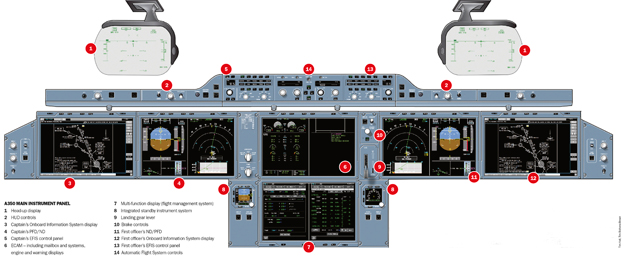
A350 main instrument panel (Click here to enlarge)
I did a few turns and minor altitude changes to acquaint myself with how the A350 felt in Normal Law. Having done digital flight control development in the F-16, I am intimately familiar with sidestick aircraft. The tactile experience of controlling the large FBW A350 with the low force displacement sidestick however, could not have been any more different than the control manipulations needed to fly a 737NG, my regular ride. Chandler then engaged Direct Law. I slowed the A350 to 180kt where I did a series of 30º turns. The aircraft felt quite responsive, but the lack of a turn coordinator necessitated the use of rudder to counteract adverse yaw. With manual thrust selected, I advanced the thrust levers. The increased thrust from the underslung engines pitched the nose of the aircraft up. Reducing power caused it to drop. Asymmetric power application caused a yawing motion. All these characteristics are masked/compensated for in Normal and Alternate Law.
As of late both Airbus and Boeing have stressed the need for pilots to get back to the basics of aviation. My short exposure to the A350’s handling qualities in Direct Law reinforced what I knew, but perhaps didn’t fully appreciate. Underneath all its automation the A350 was still an aircraft, an aircraft that adhered to the same laws of aerodynamics as the Cessna 150 I flew solo 40 years ago.
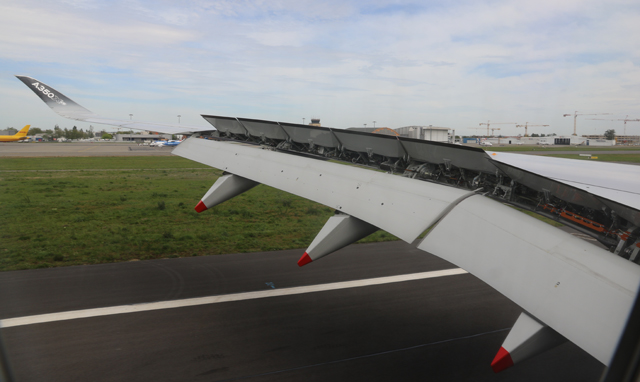
Landing roll-out with full flap and ground spoilers deployed
Max Kingsley-Jones
V2 cut
Each pilot was given the opportunity to fly one approach and landing when we returned to Toulouse. Again seated at the flight-test station in the passenger cabin, I monitored several full stop landings to runway 14L, followed by taxi back for take-offs. One interesting approach was the VOR 14L flown using the FMS Landing System (FLS). The FLS computes a final approach path, called the FLS beam. Pseudo-localiser and pseudo-glideslope information is presented in an instrument landing systems (ILS) like format making the approach easy to fly.
When it was my turn, I cycled into the left seat while on downwind in the radar pattern. Conditions were clear skies with good visibility so I elected to do a hand flown visual approach, with the ILS as a backup. With full flaps (the fourth setting), the target airspeed was 139kt for the 189t widebody (the zero fuel weight was 161.2t and fuel 27.6t). As in the simulator, I commenced the flare manoeuvre passing through 20ft RA, retarding the thrust levers to idle at the “Retard” call.
The touchdown was smooth, no doubt cushioned by the large wing-in-ground effect. The ground spoilers automatically extended on touchdown and I lowered the nose wheel to the runway. In order to save time, Chandler had suggested we do a touch-and-go, so he then retracted the spoilers, reset the trim and set flaps 2. I advanced the levers to the TOGA detent. Chandler called “Rotate” as we accelerated through 139kt, our prior target airspeed. Once airborne with the gear retracted, Chandler rapidly retarded the right thrust lever to idle to simulate an engine failure. Initially I maintained neutral control inputs to see how the aircraft would respond to the simulated engine loss. At 180kt the right wing dropped about 4º and a slow yawing motion to the right ensued. These motions provided tactile cues that alerted me to the thrust loss.
Satisfied with the A350’s docile initial response, I leveled the wings with a small lateral stick input while putting in about 6º of left rudder to center the beta target symbol on the PFD. While not quite as elegant as the thrust asymmetry compensation systems that equipped the 777 and 787, I found the handling qualities inherent in the A350’s flight control laws made an engine failure a non-event.
Autoland and BTV
Established on downwind, prior to the full-stop landing and taxi back to the Airbus ramp, I moved to the third occupant seat, located aft of the pedestal. Our final landing was used to demonstrate the A350’s autoland and BTV systems. With both autopilots and autothrust engaged, the A350 captured and tracked the Localiser course.
At one dot below the glideslope, the flaps were extended to 2. The gear was extended at glideslope intercept, with full flap set prior to 1,000ft above ground level. I watched as the vertical and lateral flight mode annunciators on the PFD changed from G/S and LOC to a single LAND indication. The autothrust flight mode annunciator indicated SPEED in green with BTV in blue below it, indicating the system was armed. The LAND flight mode annunciator cycled from FLARE then to ROLLOUT, as the automated system executed a flawless touchdown and tracked centerline on roll-out.
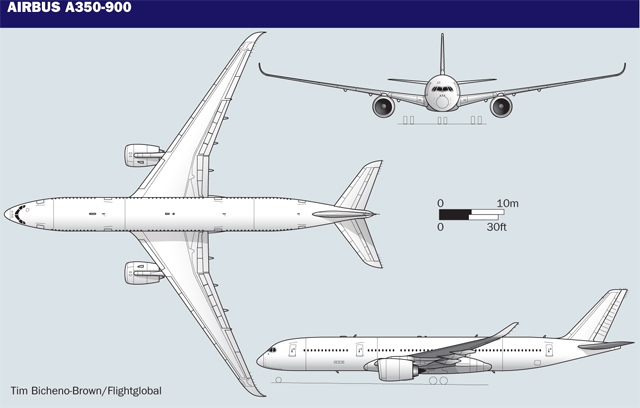
Shortly after touchdown, the BTV system activated, as indicated by the aircraft slowing and its flight mode annunciator changing to green. The BTV system is designed to slow the aircraft to a speed of 10kts, 50m prior to the selected exit point. Reaching these conditions, the BTV function automatically disconnected.
During the taxi back to the Airbus ramp, I noted that the left seat pilot found the ETACS useful in keeping the large aircraft’s gear centered on the sometimes narrow taxiways. Once parked, Chandler shut down both the Trent XWB engines and expeditiously accomplished the shutdown flows.
Extra-wonderful Airbus
During my flight in the A350-900 and companion simulator experience, I found it to be the most refined Airbus I have experienced. With its six large display screens, the flightdeck is Airbus’s cleanest to date. Any Airbus pilot would feel right at home in it, especially those flying the A330 with which it shares a common type rating.
In the air I appreciated the A350’s smooth and predictable handling qualities, finding it felt more responsive than the larger A380. Demonstrations of flight envelope protection schemes and its docile response to a simulated engine failure showed me that the A350 could be manoeuvered with confidence to its extremes. From both a pilot’s and passenger’s perspective, it seems Airbus has added yet another winner to its stable of aircraft. Some 780 orders for both A350 models confirm that Airbus’s biggest twin will be a commercial success.
Source: Flight International























